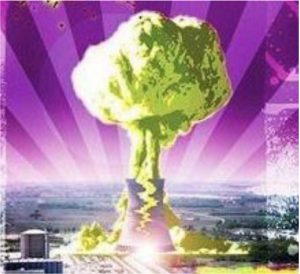Ohio's Crumbling Nukes Face Judgement Day
by Harvey Wasserman
This article originally appeared at www.freepress.org.
And was subsequently published on Reader Supported news on March 2, 2017

 he likely explosion of an American nuclear power plant is the ultimate terror in the age of Trump.
he likely explosion of an American nuclear power plant is the ultimate terror in the age of Trump.
Across the United States, 99 dangerous, decrepit, and disastrous commercial nukes are literally falling to pieces. With no private insurance and no meaningful regulation, the industry is poised to wreak apocalyptic havoc on our planet. While the industry bribes and strong-arms governors and state legislatures into massive bailouts, the next meltdown/blowup could very well cost you both your money and your life.
None of these nukes are nearer to the breaking point than Ohio’s infamous Davis-Besse reactor, near Toledo. It is poised to lose hundreds of millions of dollars for its owners and Ohio ratepayers. So, of course, the “free enterprise” Republican legislature is poised to give those nuke operators a massive bailout. To the tune of more than $4 billion (that’s not a typo).
Natural gas is cheaper. New gas plants are under construction throughout the state. Ohio has tremendous wind resources, far in excess of anything we will ever need and far more than it would take to replace DB. Thanks to spectacular technological advances in recent years, that wind power – along with new solar panels – is cheaper, safer, cleaner and more reliable than the nuke, and would create thousands of jobs beyond the few hundred at Davis-Besse.
But FirstEnergy, which owns both Davis-Besse and the legislature, does not own the gas or the wind. Davis-Besse is also poised to melt down and/or blow up. Six other reactors (Three Mile Island, Chernobyl, and Fukushima 1-4) have already done one or both.
One of the world’s oldest reactors, Davis-Besse is literally crumbling. As Kevin Kamps of Beyond Nuclear has shown, DB’s shield building has been pulverized by storms, internalized moisture that alternatively freezes and thaws, faulty maintenance, and corrupt decision making.
DB is infamous worldwide for its “hole-in-the-head” fiasco. That happened when boric acid ate nearly all the way through the reactor pressure vessel. It came within a fraction of an inch of another Chernobyl. Says Kamps: “FirstEnergy has admitted that it has known since 2011 that large chunks of Shield Building exterior face concrete could fall off – as due to an earthquake, or meltdown pressures – and fall down onto safety significant systems, structures, or components below, exacerbating the disaster, perhaps even leading to a meltdown, that the breached containment could no longer contain.”
But if the all-too-likely disaster comes, FirstEnergy will not be liable for the damages. You will pay, with your money, your property, and maybe your life.
The 1957 Price-Anderson Act was passed to encourage utility companies to build atomic reactors, which were essentially a happy face for the atomic bomb. The Atomic Energy Commission that both regulated and promoted nuclear power also produced America’s nuclear weapons. The power companies resisted the reactors because they feared meltdowns, which government reports at the time presciently warned could wipe out an area the size of Pennsylvania. The industry at the time promised electricity “too cheap to meter” and denied a commercial reactor could ever explode. Both statements proved to be epic lies.
Meanwhile a captive Congress let the industry proceed without liability insurance. A tiny ($540 million) fund was set up, essentially for show. That’s now up to about $13 billion. But considering Chernobyl did at least a half-trillion in damage and Fukushima more than anybody can yet calculate, the kitty is essentially an absurdity. A radioactive cloud pouring out of Davis-Besse would do $13 billion in damage to life and property within the first few miles.
The rest would be paid for by the public – you and me. After 60 years, American reactors still have no private liability insurance.
Protected by the government, FirstEnergy has no corporate stake in protecting the people or property downwind. Some workers might care. Some executives might be perpetually poised to flee the inevitable apocalyptic cloud as it hurtles toward their lakefront mansions.
But as an inanimate entity, the company itself is immune to radiation. Should the corporate shield crumble, bankruptcy is the easy and obvious option.
Which is what FirstEnergy may face at Davis-Besse. Among the world’s very oldest reactors, its operating and maintenance costs have soared. Even with the fake regulation provided by the rubber stamp Nuclear Regulatory Commission, DB faces massive repairs just to keep its turbines twirling. The building has already been slashed into four times to replace core components. It’s the equivalent of having four open-heart surgeries (if a reactor can be said to have a heart) through a rib cage that cannot heal, with each invasion accelerating general deterioration.
As Sierra Club energy expert Ned Ford explains, the economic crisis FirstEnergy now faces is of its own making. Many years ago, when it was known as Cleveland Electric Illuminating (and then Centerior, also encompassing Ohio Edison) the utility’s financial geniuses gouged out of the legislature a massive bailout for Davis-Besse and its compadre Perry reactor east of Cleveland. Together they took what energy expert Ned Ford estimates to be up to $20 billion from Ohio ratepayers.
At the time they argued (with straight faces) we’d all save millions in an open “free market” competition. But to get there, they insisted we underwrite the two lakefront nukes, which could not compete without gargantuan handouts that made a mockery of that old “too cheap to meter” pitch.
The legislature, of course, gave them all they wanted. We who testified against this outrageous stick-up warned that the “free market” reactor operators would be begging for re-regulation.
Why?
Because nukes can’t function without huge subsidies. Regulation guarantees a return on investment at ratepayer expense (which has never bothered a “free market” utility).
As Ned Ford has extensively shown, Ohio has huge excess capacity in coal-burners, though many are as decrepit and dysfunctional as Davis-Besse. It’s also over-built in gas burners, many of which sat unused when methane prices were high, but which now churn out juice far cheaper than any nukes anywhere.
Most importantly, northern Ohio has spectacular wind resources. The breezes in the middle of Lake Erie are as strong and steady as anywhere on Earth. The lake is relatively shallow and fresh, meaning there’s no salt to corrode the moving parts. The likely sites are also relatively close to Toronto, Detroit, Toledo, Cleveland and other major consuming centers.
On-shore is even better. The winds aren’t as strong, but installation is cheaper and there’s plenty of transmission, many willing farm hosts, and good proximity to the cities. Alongside solar cells, wind is humankind’s fastest-growing new energy source, creating millions of jobs worldwide – tens of thousands of which are poised to pour into Ohio whenever the nukes finally shut. Advanced reliability has driven capacity factors constantly higher, with downtime increasingly covered by a revolution in battery technologies.
In 2010 a broad coalition of activists, working with Governor Ted Strickland, put a far-seeing energy plan in place to take Ohio deep into a green energy future. The pioneer package of goals and incentives was set to bring the Buckeye State an energy mix that was clean, cheap, cutting-edge, and poised to create thousands of jobs in an advanced economy that could have pulled Ohio far ahead of the rest of the rust belt and into a truly sustainable post-recessional future. Several billion dollars in investment capital – much of it focused on wind farms in northern Ohio – was ready to go.
But with the coming of John Kasich and a Koch-controlled legislature, all that disappeared. Kasich has since softened his anti-green tone. But the legislature is still run by far-right corporate Republicans who hate anything that’s not fossil/nuke, even if there are jobs and money to be made and a sustainable future to be had. They also hate anything that smacks of government interference or handouts – until a big corporate donor like FirstEnergy demands billions in ratepayer subsidies for uninsurable privately-owned reactors that put the public at risk.
Indeed, FirstEnergy is now unabashedly asking this “anti-government” legislature to guarantee its return on nuclear investments whose real dollar values are a huge negative. Massive quantities of radioactive trash have piled up at the reactor sites with nowhere to go. The pioneer American radioactive waste facility – New Mexico’s Waste Isolation Pilot Project –blew up three years ago at an estimated cost of $2 billion and counting. Nevada’s Yucca Mountain, decades from being completed if at all, will be even more unstable, with an ultimate price tag approaching $100 billion.
Both Ohio reactors are gargantuan liabilities demanding inestimable resources to decommission. Funds have been accumulated to allegedly pay for that, but nobody seriously believes there’s enough to do the job.
The nuclear industry has also adopted the astonishing lie that these reactors are somehow “zero emission” and therefore help fight global warming. It’s an amusing argument, coming from Republicans who adamantly denounce the idea that climate change might be real.
It’s also blatantly false. Davis-Besse, Perry, and all other reactors dump billions of gallons of heated water directly into the air and water. They thus “fight climate change” by directly heating the climate. They also emit Carbon 14 in their fission process, and many tons of carbon dioxide in the process of mining, milling, and enriching their uranium fuel.
Nukes also constantly emit radioactive gases and particulates that kill living things, both in their “normal” operating process and when they explode, as at Chernobyl and Fukushima.
Above all, they have been blown away economically by the revolution in solar and wind. More than 260,000 Americans now work in the solar industry and more than 100,000 in wind, far more than in coal, oil, and nukes combined. Every time a reactor shuts, opportunity arises to create thousands of stable, long-term, well-paying jobs in renewables and efficiency. The faster the reactors shut, the more jobs are created and the safer, cleaner, and cooler the planet becomes.
If Ohio’s legislature does re-regulate and hand FirstEnergy its radioactive ransom, lawsuits will erupt (as they already have in Illinois) from independent “market” utilities seeking to compete. The type of monopoly status the “free market” Republicans are poised to give FirstEnergy will be challenged in the courts and regulatory agencies in hugely expensive litigations. The only certain outcome is years of delay and a yet another massive price tag – which FirstEnergy would stick to the rest of us.
Also certain would be the devastating impact on Ohio’s economic future. As shown by the Sierra’s Ford, the billions sucked up by these ancient, obsolete nukes have poisoned the Buckeye economy and helped hollow out what was once an industrial powerhouse. The only jobs created will be among the attorneys adding their exorbitant fees onto the ratepayers’ tab.
The revolution in wind and solar that’s sweeping the planet should long ago have brought Ohio’s economy into the new millennium.
Instead, these massively subsidized, crumbling, obsolete radioactive jalopies keep on rumbling toward the inevitable atomic cliff. What melted TMI, Chernobyl, and the Fukushimas draws closer every day.
Likewise the shameless, self-serving, and unconscionable campaign FirstEnergy has launched to force us all to yet again fund our own economic, employment, ecological and biological demise.
FirstEnergy now says it will sell Davis-Besse and get out of the generating business. But the deal will be meaningless if DB continues to operate.
Somewhere along the line, Ohioans must find those two off-switches at Perry and Davis-Besse while turning on the revolution in wind and solar power that is bringing jobs and prosperity to so much of the rest of the world.
Harvey Wasserman is author of SOLARTOPIA! OUR GREEN-POWERED EARTH, available viawww.solartopia.org. He edits www.nukefree.org. This article originally appeared at www.freepress.org.
]]>
 s you ride the Amtrak along the Pacific coast between Los Angeles and San Diego, you pass the San Onofre nuclear power plant, home to three mammoth atomic reactors shut by citizen activism.
s you ride the Amtrak along the Pacific coast between Los Angeles and San Diego, you pass the San Onofre nuclear power plant, home to three mammoth atomic reactors shut by citizen activism.
 100 Larkin Street
San Francisco, California 94102
(Downstairs in the Latino/Hispanic Room)
““““`
100 Larkin Street
San Francisco, California 94102
(Downstairs in the Latino/Hispanic Room)
““““`
 1606 Bonita (@Cedar)
Berkeley
Second Floor, Connie Barbour Room.
$5 donation requested – no one turned away for lack of funds
(sponsored by BFUU Social Justice Committee & Code Pink Women for Peace)
1606 Bonita (@Cedar)
Berkeley
Second Floor, Connie Barbour Room.
$5 donation requested – no one turned away for lack of funds
(sponsored by BFUU Social Justice Committee & Code Pink Women for Peace)
 Japantown Peace Plaza
1748 Buchanan at Sutter
San Francisco, California 94115
Japantown Peace Plaza
1748 Buchanan at Sutter
San Francisco, California 94115
 2017 Mission St, San Francisco, CA 94110
(Near 16th Street BART)
““““`
2017 Mission St, San Francisco, CA 94110
(Near 16th Street BART)
““““`